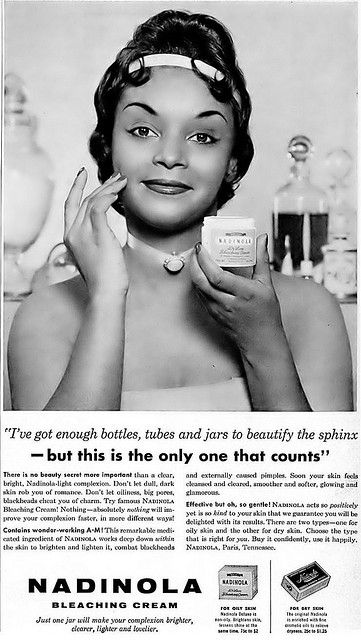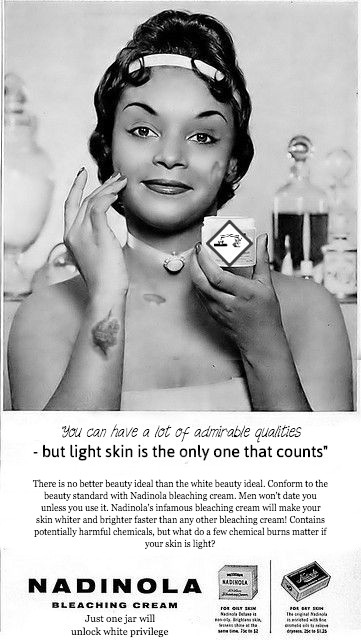Culture Jam: Colourism and White-Centric Beauty Standards

According to Wolf (as cited in Nicholson, 2010), Western beauty standards are very narrow and leave out many groups of women, yet they dictate women’s decisions in life. The beauty ideal is often described as thin and light-skinned with European features. Bleaching creams, such as the one depicted in this advertisement, serve to reinforce this standard of beauty. The main slogan in this advertisement says that Nadinola bleaching cream is “the only [beauty product] that counts” (Reyes, n.d.) This suggests that one cannot be attractive unless they have light skin that meets the beauty ideal. The advertisement promotes colourism within black groups in addition to racism by promoting the value of light skin.
In smaller print, the advertisement also suggests that having a dark complexion will negatively affect one’s romantic relationships, stating “Don’t let dull, dark skin rob you of romance” (Reyes, n.d.). Given that becoming a wife and mother is essential to the lives of many women (especially during the time that this advertisement would have been printed), preying on women’s fear of not finding a romantic partner could convince them to buy this product (Nicholson, 2010). Radical feminists pioneered for separation from men and shunned patriarchal beauty standards during the feminist movements of the 1960s and 1970s. However, only a small group of privileged women could realistically forego these beauty practices (Nicholson, 2010). This leaves out black women and other women of colour. Men in the black power movement still saw black women as lesser, comparing their respective values to gold and silver. Black nationalist men proclaimed that “there is no house/family without a man and his wife” (The Combahee River Collective, 2014, pg. 277). As the Combahee River Collective (2014) explain, separation from men would negatively affect the balance in the lives of black women. While Nadinola was not exclusively marketed to black women, it was primarily marketed to black women. Advertisements for bleaching creams like this can be thought of as the interlocking result of racism and sexism experienced by black women. They enforce a beauty ideal that is both white and supposedly necessary to attract a husband.
As a last thought, bleaching creams can contain harmful chemicals such as mercury (Engler, 2005). However, the advertisement praises the gentle formula of the product and neglects to mention any safety warnings.

In the jammed version of the advertisement, I changed the main slogan to emphasize the suggestion that white skin is more valuable than black skin. While the original advertisement proclaims Nadinola is the most important beauty product a woman could have in her bathroom cabinet, it is really not-so-subtlety suggesting that the bleaching effect of Nadinola is more beautifying that any lipstick, blush, or powder could ever be. In fact, having darker skin will “cheat you of your charm” (Reyes, n.d.). The advertisement in its whole is saying that light skin is not just the most physically beautiful quality you can have, it is also the best quality you can have period. I attempted to subvert this message and highlight the underlying racist and sexist message with the new headline and product description. Nadinola’s claim that having dark skin will ruin your chances at love is already clear, but I highlighted the fear mongering aspect by changing it simply to “Men won’t date you unless you use [Nadinola].”
I changed the message in the bottom left corner to “One jar will unlock white privilege.” Central to this advertisement is the issue of colourism and racism. Light skin is not seen as more valuable than darker skin for no reason. Fukuo (as cited in Apuke, 2018) says that light skin is associated with people who possess privilege and high status, and that having light skin is necessary to attract a romantic companion of high status for women. Bleaching creams lighten skin and thus bestow more privilege to the individual.
Many bleaching creams can contain toxic mercury (Engler, 2005). I highlighted the danger of bleaching products by adding a corrosive symbol to the jar and chemical burns to the model’s arm, chest, and face. I also mention the potential dangerous ingredients and side effects (i.e. chemical burns) in the description as a counter to Nadinola’s claims that the product is gentle. Given the promotion of light skin in the advertisement, I wrote in the jammed advert that chemical burns are worth the risk for lighter skin.
References
Apuke, O. (2018). Why do women bleach? Understanding the rationale behind skin bleaching and the influence of media in promoting skin bleaching: A narrative review. Global Media Journal, 16(3), 1-4. Retrieved from: sciencedirect.com
Engler, D. E. (2005). Mercury “bleaching” creams. Journal of the American Academy of Dermatology, 52(6), 1113-1114. Retrieved from: sciencedirect.com
Nicholson, L. (2010). Feminism in “waves”: Useful metaphor or not? New Politics 12(4).
Reyes, C. [Charmaine]. (n.d.). Extreme skin lightening, natural skin bleaching without hydroquinone [Pinterest post]. Retrieved from https://www.pinterest.ca/pin/170503535865050215/
The Combahee River Collective. (1977/2014). A Black Feminist Statement. Women’s studies Quarterly 42(3-4), 271-280.